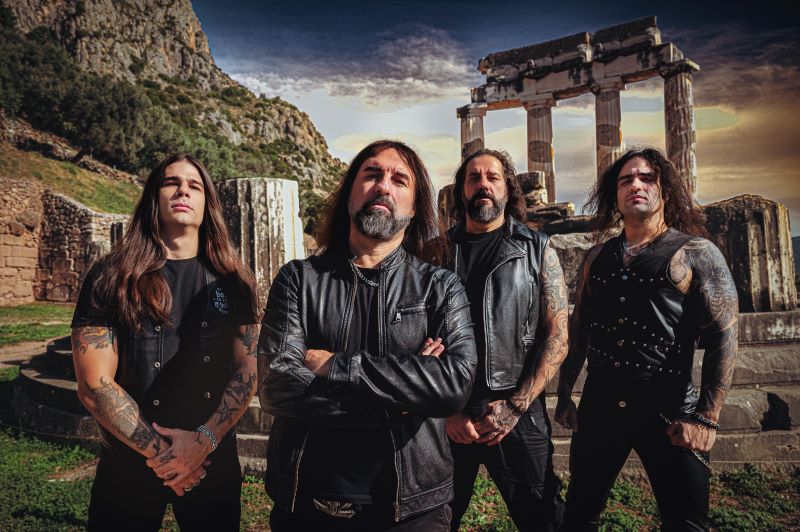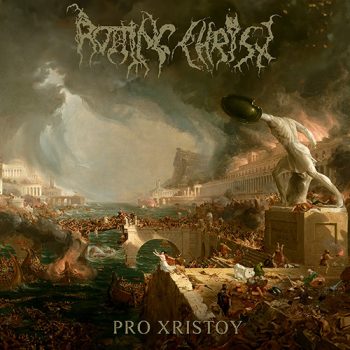Twice the darkness, twice the devastation, twice the blasphemy. That’s our Twice As Heavy feature. A new, long-awaited record that simply demands to be looked at from more than one angle. This time we delve into Pro Xristou by Rotting Christ. Marleen (favourite genre: black) and her partner Sander (favourite genre: melodic death) are the lucky ones this time.
Rotting Christ needs no further introduction on this website after their 35-year-old career. Their latest album, The Heretics, dates back to 2019, while traditionally there’s a three-year interval between albums. The reason for the delay is, of course, the pandemic. Although band leader Sakis Tolis had plenty of time to write music during that period, the recording had to be postponed. He also used that time to create solo music, wanting to experience making an album without labels, contracts, and deadlines.
Now, it’s time for the fourteenth album from the pioneers of Hellenic Black Metal. Pro Xristou was produced by Sakis himself in Greece and mixed by Jens Borgen (Paradise Lost, Dimmu Borgir, Opeth) in Sweden. Tony Lindgren (Wardruna, Billie Eilish, Powerwolf) handled the mastering there.

Does Pro Xristou follow the beaten path or is there innovation?
Marleen: Thematically, Pro Xristou continues from The Heretics. For instance, The Apostate pays homage to the last pagan emperor, Julian the Apostate: “No wild beasts are so dangerous to men as Christians are to one another. And concerning the book you gave me to read, I read, I understood, I condemned.” Fantastic! Saoirse is also a tribute to a historical figure: the last king who resisted the spread of Christianity, the King of Tara (Ireland). And when it comes to values and wisdom from the pre-Christian era, Norse mythology certainly cannot be left out. Enter the track Yggdrasil. Musically, Rotting Christ has also not reinvented themselves on Pro Xristou. More on that later…
Sander: Pro Xristou stays on the same path that Rotting Christ embarked on with Kata Ton Daimona Eaytoy. And that is a good development. Sakis’ voice fares better with low, deep growls and spoken word than with screams. The rhythmic and ritualistic style remains a prominent concept of their work. However, I must conclude that The Heretics was stronger and more innovative musically. A track like The Raven (a personal favourite) is not found on Pro Xristou. Furthermore, many riffs seem somewhat similar, but more on that later. To stay in a positive spirit: I do want to buy this album. Tracks like La Lettera Del Diavolo, The Farewell, and Pix Lax Dax worm their way into your ears with beautiful guitar work and strong vocals. Like Father, Like Son has an almost relaxed character – and a beautiful message. The closing track Saoirse rounds it all off with choir singing and the tragic end of the pagan era before the dominance of Christianity began. So, definitely buy this record!
Marleen: In my opinion, Pro Xristou sits in the twilight zone between Rotting Christ and Sakis Tolis solo. Recycling is very sustainable, of course, but when it comes to riffs, I prefer newly created ones. I constantly feel like I’ve heard the compositions before, albeit at a slightly different tempo. This is perhaps not entirely surprising since the songs were all written around the same period. But with The Sixth Day, the similarities are so serious that I spontaneously start singing the lyrics of My Salvation, coming from the album Among the Fires of Hell. At the same time, The Apostate sounds very much like Dies Irae from The Heretics. And there are more examples like this. The album is full of not rip-offs, but riff-offs. And I find that quite annoying. The only truly original, interesting composition is found in La Lettera Del Diavolo.
Sander: Unfortunately, I have to note that there is a lot of overlap with Sakis’ first solo album Among the Fires of Hell. This is particularly noticeable in The Sixth Day and Pix Lax Dax. Although both tracks are good in their own right, connoisseurs of Sakis’ solo album will feel a strong sense of recognition. The riff of The Sixth Day is almost identical to that of My Salvation, and the guitar part of the verse of Pix Lax Dax is an almost exact copy of The Dawn of a New Age but slower. Is that bad? Not necessarily, but it does raise the question of how original this work truly is.
Marleen: None.
Sander: Definitely during La Lettera Del Diavolo, especially the chorus that kicks off strongly with “I am the voice, the voice of god… You give me voice, you made me strong.” This quote captures the essence of religion very well. Man has invented god, given him a ‘voice’ through institutional religion, and thus made him powerful. Additionally, you can hear the human tendency to attribute divine meaning to natural events. “I am creation, you named me god” sums it up beautifully. Besides the philosophical touch, this chorus draws attention with Sakis’ thundering voice, the wonderful guitar riff, and the female guest vocals in the background. Certainly the highlight of the album!
Rotting Christ is a true live band. Which track are you most looking forward to experiencing live?
Marleen: Then I choose the last track, Saoirse. That cheer for our freedom will feel great. It also somewhat resembles Non Serviam in feeling, which is my personal anthem. But with a bit of luck, just like with The Heretics tour, there will be little new in the setlist, and we’ll get to enjoy the old classics. We’re definitely going to see them live at Samhain Festival in Maastricht on October 27!
Sander: Pix Lax Dax will surely get heads banging live. I also hope to catch La Lettera Del Diavolo, which has the most energy of all the work on the album. Additionally, I hope to see the solo of The Sixth Day performed on stage to dream away to. That should be allowed at a metal concert, right?
Marleen: No, I needed to adjust my expectations right away. Musically, Pro Xristou turned out too generic. The only truly original track is La Lettera Del Diavolo. That’s too scant for this seasoned fan. And the fact that the exact same painting was also previously used by Heaven Shall Burn for the album cover (see Protector, 2020) adds up. Thematically, however, Rotting Christ hits the bullseye. Pro Xristou offers an important history lesson that is thought-provoking. And Rotting Christ remains an unshakeable pillar of Greek metal. Those few readers who are not yet familiar with Rotting Christ and Sakis Tolis should feel free to add ten points to my symbolic score.
Sander: I don’t think so. It’s a good album with solid tracks, but I wouldn’t call it truly innovative. It’s a small step down from The Heretics. But to be fair, you still have a good album that you can listen to with great pleasure. And that’s something I will continue to do.
Score Marleen: 66,6/100
Score Sander: 75/100

Score:
71/100
Label:
Season of Mist, 2024
Tracklisting:
- Pro Xristou (Προ Χριστού)
- The Apostate
- Like Father, Like Son
- The Sixth Day
- La Lettera Del Diavolo
- The Farewell
- Pix Lax Dax
- Pretty World, Pretty Dies
- Yggdrasil
- Saoirse
Line-up:
- Sakis Tolis – Vocals, guitar
- Themis Tolis – Drums
- Kostas Foukarakis – Guitar
- Kostas Cheliotis – Bass guitar
Links:












